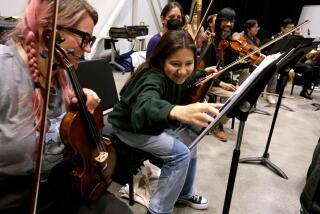Coalition misses mark on fine-tuning its parts
- Share via
Guitarist Doug MacDonald came up with an unusually fascinating concept in the performance of his Brass and Woodwind Coalition on Thursday at Spazio in Sherman Oaks.
Combining a woodwind quintet with a brass quintet (overlapping via the French horn of Stephanie O’Keefe, which served as the fifth instrument in each grouping), he added a four-piece rhythm section and presented one of the most sonically intriguing large jazz groups of recent memory.
Although the combination differed from the traditional big jazz band assemblage of trumpet, trombone, saxophone and rhythm sections, many of the orchestrations employed familiar big band techniques.
With the woodwind grouping essentially serving as saxophones, the brass serving as a trumpet and trombone coalition, the arrangements frequently followed the long established practice of either pitting one section against the other or joining them into a solid mass of sound.
Nothing wrong with that, of course, since it’s worked effectively with everyone from Duke Ellington to Wynton Marsalis. For a good part of the Coalition’s performance, however, one couldn’t help but feel that a creative opportunity had been minimized.
The unique timbres of the woodwinds -- flute, clarinet, oboe and bassoon -- were too often buried rather than showcased in all their almost infinite combinations of sound. And the brass quintet, with its similarly colorful potential, generally came across as a typical jazz brass section.
In the passages in which O’Keefe’s French horn was allowed to soar, Bob Carr’s contrabass clarinet rumbled through the ensemble, and Phil Feather’s oboe and Bobby Shulgold’s flute did more than flit through the background, the very real possibilities of the Brass and Woodwind Coalition began to emerge. But those moments were too few and too far between.
More to Read
The biggest entertainment stories
Get our big stories about Hollywood, film, television, music, arts, culture and more right in your inbox as soon as they publish.
You may occasionally receive promotional content from the Los Angeles Times.










